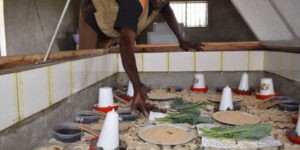In 2017, scientists proposed that farming crickets could be safer for the environment compared to chicken rearing.
The study is believed to have strengthened the resolve of the farmers who have embraced cricket farming.
FARMING

Charles Orinda is a cricket farmer from Kisumu and uses the insect as a source of food and income.
Charles processes dried cricket into flour using locally fabricated machines to make cakes, muffins, and biscuits for sale.
In his farm in Nyamasaria, the crickets are housed under sheds that are kept clean and insects are routinely supplied with clean water and food such as crushed grain, sukuma wiki, and some traditional herbs.
The insects are also fed on fish meal, soybean, and some minerals dissolved in water.
Odiya notes that these insects require a high supply of protein and minerals to breed and survive and if they lack they could eat other crickets.
“They require strict hygiene. So you have to keep cleaning their sheds from time to time, emptying the waste and ensuring no contamination,” Odira said are reported.
CARE
The crickets breed quickly, often multiplying with 10 days.
They are susceptible to bacteria but a dirty environment makes them escape.
“Experts say if you eat two crickets in a week you are guaranteed more protein content than one person who eats chicken regularly. Also, they are safer for the environment,” says Odira.
RESEARCH
According to a study done by scientists at the University of Copenhagen to compare cricket production in Thailand to broiler chicken farming on the same scale, it found that crickets were better for the environment.
During the study, fifteen environmental impacts were investigated, including resource depletion, global warming, and eutrophication.
The report found out that cricket production had a lower negative impact on the environment compared to chicken rearing.
Additionally, cricket rearing is independent of climate change hence farmers can rear then throughout the year, and thus their profitability is sustainable.
According to Egerton University Department of Dairy Food science researcher Godfrey Were, chicken production produces more waste than crickets despite giving them the same amount of food.
In a publication by Daily Nation, Were said: “Generally broiler chicken feed a lot compared to cricket. As a result, chicken ends up producing more waste than cricket who gives low output to the environment.”
According to him, the methane gas produced by chicken waste is higher than the wasted produced from crickets.
“Because of the small contribution of waste of crickets they are seen to have little contribution to the global warming effect and environmental degradation,” he said.
FEED
Chicken feed that is also fed to crickets is a mixture of corn or maize, soy, fishmeal, and rice meal.
Framed crickets are noted to be extremely efficient at converting the feed given to them – which is the same amount as that this to broiler chickens – into protein.
“If you give 5gm of feeds to both chicken and cricket, the conversion of the protein in crickets is higher than broiler chicken,”
Reared crickets have double the number of protein content compared to broiler chicken.
“House reared crickets to have 60 percent protein content compared to chicken which has slightly protein content of 30 percent,” Were noted.
- DPP Haji Orders Arrest Of Tharaka Nithi Governor Njuki
- Film Hero arrested by government on terror-related charges
- Police Officer Involved In George Floyd Murder Asks Court To Dismiss Case
- Senator Malala gives details of assassins who want to kill him
NUTRITION
In many cases, crickets can be comparable to fish and meat in terms of nutritional value.
The Association of Dutch Insect Farmers says cricket farming is a viable option for solving widespread cases of malnutrition and kwashiorkor.
Crickets can be captured in the wild and reared in a close set-up. Mostly the insects take a few weeks for adult females to start laying eggs which can be used to expand the farm.
The insects are rich in fatty acids, vitamin B12, iron, and calcium.